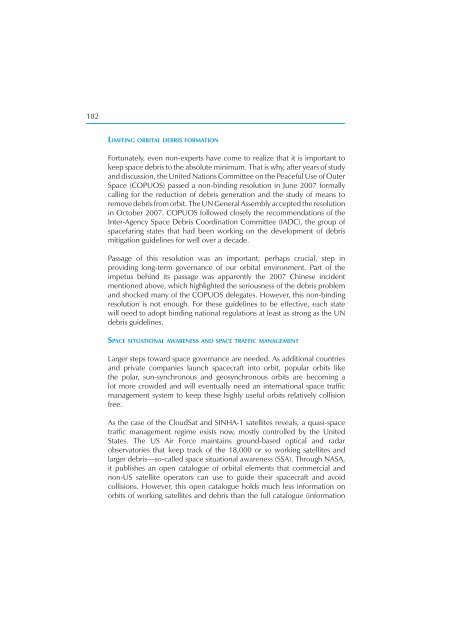Security in Space The Next Generation - UNIDIR
Security in Space The Next Generation - UNIDIR
Security in Space The Next Generation - UNIDIR
You also want an ePaper? Increase the reach of your titles
YUMPU automatically turns print PDFs into web optimized ePapers that Google loves.
182<br />
LIMITING ORBITAL DEBRIS FORMATION<br />
Fortunately, even non-experts have come to realize that it is important to<br />
keep space debris to the absolute m<strong>in</strong>imum. That is why, after years of study<br />
and discussion, the United Nations Committee on the Peaceful Use of Outer<br />
<strong>Space</strong> (COPUOS) passed a non-b<strong>in</strong>d<strong>in</strong>g resolution <strong>in</strong> June 2007 formally<br />
call<strong>in</strong>g for the reduction of debris generation and the study of means to<br />
remove debris from orbit. <strong>The</strong> UN General Assembly accepted the resolution<br />
<strong>in</strong> October 2007. COPUOS followed closely the recommendations of the<br />
Inter-Agency <strong>Space</strong> Debris Coord<strong>in</strong>ation Committee (IADC), the group of<br />
spacefar<strong>in</strong>g states that had been work<strong>in</strong>g on the development of debris<br />
mitigation guidel<strong>in</strong>es for well over a decade.<br />
Passage of this resolution was an important, perhaps crucial, step <strong>in</strong><br />
provid<strong>in</strong>g long-term governance of our orbital environment. Part of the<br />
impetus beh<strong>in</strong>d its passage was apparently the 2007 Ch<strong>in</strong>ese <strong>in</strong>cident<br />
mentioned above, which highlighted the seriousness of the debris problem<br />
and shocked many of the COPUOS delegates. However, this non-b<strong>in</strong>d<strong>in</strong>g<br />
resolution is not enough. For these guidel<strong>in</strong>es to be effective, each state<br />
will need to adopt b<strong>in</strong>d<strong>in</strong>g national regulations at least as strong as the UN<br />
debris guidel<strong>in</strong>es.<br />
SPACE SITUATIONAL AWARENESS AND SPACE TRAFFIC MANAGEMENT<br />
Larger steps toward space governance are needed. As additional countries<br />
and private companies launch spacecraft <strong>in</strong>to orbit, popular orbits like<br />
the polar, sun-synchronous and geosynchronous orbits are becom<strong>in</strong>g a<br />
lot more crowded and will eventually need an <strong>in</strong>ternational space traffi c<br />
management system to keep these highly useful orbits relatively collision<br />
free.<br />
As the case of the CloudSat and SINHA-1 satellites reveals, a quasi-space<br />
traffi c management regime exists now, mostly controlled by the United<br />
States. <strong>The</strong> US Air Force ma<strong>in</strong>ta<strong>in</strong>s ground-based optical and radar<br />
observatories that keep track of the 18,000 or so work<strong>in</strong>g satellites and<br />
larger debris—so-called space situational awareness (SSA). Through NASA,<br />
it publishes an open catalogue of orbital elements that commercial and<br />
non-US satellite operators can use to guide their spacecraft and avoid<br />
collisions. However, this open catalogue holds much less <strong>in</strong>formation on<br />
orbits of work<strong>in</strong>g satellites and debris than the full catalogue (<strong>in</strong>formation








